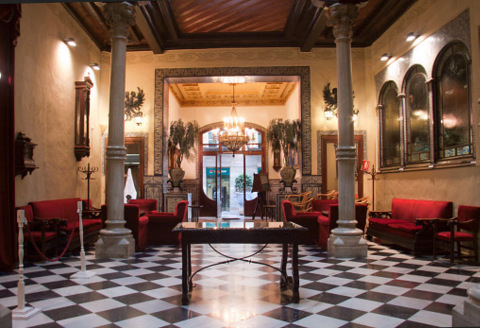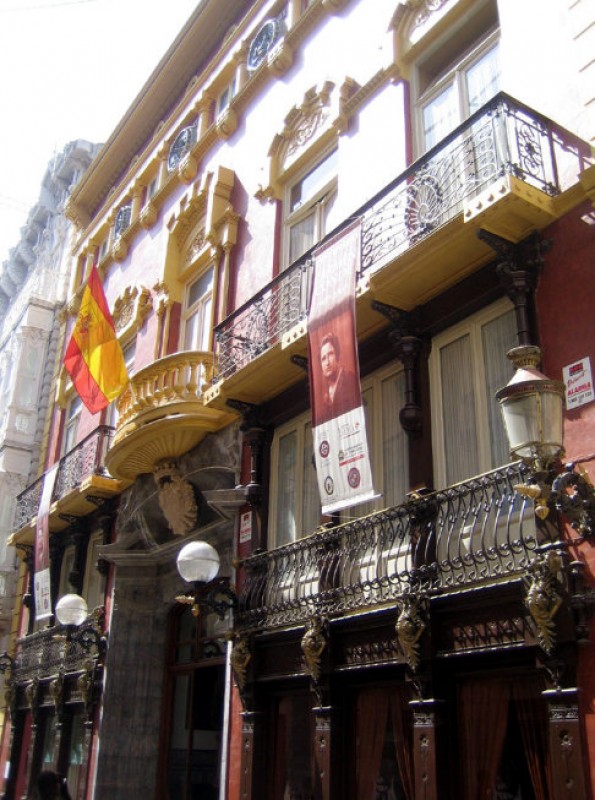The Casino of Cartagena

The Casino occupies an 18th century palatial home in the centre of Cartagena
The casino of Cartagena occupies an impressive 18th century building in the main pedestrian street of the old city centre, the Calle Mayor, just a couple of hundred metres from the Palacio Consistorial (the main Town Hall building) and the seafront in the port.
What is now the casino was originally built as the palatial residence of the Marqués de Casa Tilly, and construction began in 1762 at the behest of the first Marquis, Francisco Javier Everardo-Tilly, who was a  navy captain. In order to make his project possible Tilly acquired two large houses in the Calle Mayor, as well as a couple of other, smaller properties which stood alongside.
navy captain. In order to make his project possible Tilly acquired two large houses in the Calle Mayor, as well as a couple of other, smaller properties which stood alongside.
Following the death of the second Marquise, Pascuala, in 1830, the palace was occupied by María Dolores de Borja y Fernández Buenache, the Marquesa de Camachos, and her husband Pedro Rosique y Hernández, until 1836, and it was not until 1861 that the Sociedad del Casino began to rent the property under the name of Casino Círculo Cartagenero.
The building was eventually sold to Francisco Martínez Hernández in 1886, and the following year he signed over the property to Ricardo Spottorno, representing the Sociedad de Recreo Casino de Cartagena. The purchase was not finally completed until a few years later.
At this point extensive reforms were undertaken under the auspices of José Ramón Berenguer, and the façade which can be seen today was designed by Francisco de Paula Oliver in 1896. On the upper floors all of the decorative exterior elements are made of zinc, while the lower floors are finished in wood.
However, it is also possible to see the influence of Víctor Beltrí, the man who was responsible for so many of the Modernist buildings in Cartagena in the late 19th and early 20th centuries, as it was he who was appointed to supervise the reforms in 1897.
Inside, lip service is still paid to the original distribution of rooms which was designed for the Marquis of Tilly, with a central cloistered patio (now covered by a skylight) which provides light to many of the interior rooms and a grand staircase set to one side. The tiling in the entrance hall represents characters from the “Golden Century” of Spanish literature, while the marble columns were added by Beltrí, and also on the ground floor is the main hall, a reading room, a café and the restaurant: these last two are open to the public.
Upstairs are meeting rooms, a games room, the billiards room, the “Sala de Espejos” (hall of mirrors), another room known as the “Salón de los Dragones” on account of the decoration on the ceiling, and various other living rooms for use by members. Curiously, there is also a fencing hall, while the second floor houses the casino library.
Unsurprisingly, the furniture is predominantly Modernist, and includes items from Vienna in the reading room, the cloakroom and the entrance lobby. The tiling is from Triana in Sevilla, two large ornamental lamps are French in origin and the wooden staircase was designed by Amaré, who also carried out the wrought ironwork of the railings.
The dancing hall is lavishly decorated with floral motifs and illuminated by a spectacular chandelier known as “Gloria Coronoando el Genio”, and the walls of the library are sumptuously clad in wooden panels.
In order to understand the nature of the Casino, it is important to remember that the word does not refer in Spanish to a gaming and betting establishment along the lines of Monte Carlo or Las Vegas. Rather it refers to what in the UK might be the equivalent of a gentlemen’s club, a place where the upper echelons of society (always male at the time the Casino was founded) could meet at their leisure to discuss the topics of the day, both important and, on occasion, trivial. At the same time, the casino was intended to provide for its members an atmosphere of tranquility and relaxation, hence the need for luxurious surroundings, libraries, billiards rooms and the like.
In Cartagena many of the first members of the Casino belonged to the new bourgeois class which had become rich as a result of the mining activities in the mountains close to the city during the second half of the 19th century, and after the visit of Isabel II to Cartagena in 1862 the members had begun to speak of the need for a premises befitting what they described as their “importance, their history and the social class they represent”.
In many ways this attitude still persists among members well over a century later, and most of the Casino is not open to the public. However, an agreement has been reached with the Town Hall by which, in exchange for help in restoring and maintaining the building, it can occasionally be used for events which are open to the general.
The Casino of Cartagena is at Calle Mayor nº 13.
For more local visiting information, waht's on and news go to the Cartagena section of Murcia Today.





 navy captain. In order to make his project possible Tilly acquired two large houses in the Calle Mayor, as well as a couple of other, smaller properties which stood alongside.
navy captain. In order to make his project possible Tilly acquired two large houses in the Calle Mayor, as well as a couple of other, smaller properties which stood alongside.